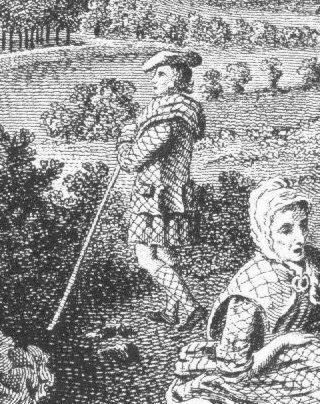|
-
30th November 09, 09:52 PM
#1
 Philabegs Philabegs
Hi all anyone know a place to get a historical accurate Philabeg?
or would the great kilt be more right for 1745?
Thanks for the help 
-
-
30th November 09, 10:30 PM
#2
I'm not into re-enacting, nor have I done business with them but have you seen this site ? I'm pretty sure others have here have done business with them and were pleased.
Just my two kopecks.
-
-
1st December 09, 04:00 PM
#3
Philabegs were in widespread use by the time of the `45, though the belted plaid ("great kilt") was probably more common for "campaign" usage, as it doubled as the clansman's blanket in the field. A philabeg wearer would still carry a "shoulder plaid" however, of smaller dimensions than the full-sized plaid, along these lines:
 
Anyways, those philabegs from Celtic Croft are fine. I'd get the pleats stitched into place...!
Brian
"They who can give up essential liberty to obtain a little temporary safety, deserve neither liberty nor safety." ~ Benjamin Franklin
-
-
1st December 09, 05:50 PM
#4
In both the "Seven Year's War" ("French and Indian War" for North American folk) AND the "War of the American Rebellion" ("American Revolution" although as with the "Seven Year's War", it TOO was really a "World War"), the 42nd was shipped over with the Belted Plaide and later, due to supply problems in getting new Plaides (they were to be issues every two years), ripped what was left of the original Plaides into single-loom widths and made them into philabeags.
There is (in letters, journals, etc.) some mention of "loops", "stitching", "keepers", etc., and of course, drawstings or cords.
I have the full Plaidie for the issued uniform. I just did a philabeag (4 yard), kinife-kilted (because that's the way the full Plaide was done) to the line, with three horizontal lines of long stitching on the rise (to hold the pleats... something that looks as it might have been if done in the field). To finish up the trio I did (using the 1789 "Gordon" as an inspiration) a 4 yard philabeag kilted to the line, box pleated, with the pleats sewn vertically. Neither philabeag has lining or fitting... straight up and down lines. IIRC the Regiment went to "trousers" by 1779 and went out in '83 still wearing "trousers".
Certainly there's nothing to it in making your own. This was originally done in the field out of neccessity. For a more modern issue, once the philabeags had replaced the full Plaide, that requires a bit more effort and for certain, the kilt after the Napoleonic period gets even more complicated.
added: All three "kilts" are held on by belting on, no ties or anything. An interesting thing I learned doing the project was that the philabeag (if the waist was folded down on itself) would actually hold up very well WITHOUT belting it on. The nap of the weave locked it on good and tight!
For the '45, do it yourself!
Jim aka kiltiemon
Last edited by james a. husky; 1st December 09 at 05:56 PM.
-
-
6th February 10, 05:55 PM
#5
 Originally Posted by james a. husky

In both the "Seven Year's War" ("French and Indian War" for North American folk) AND the "War of the American Rebellion" ("American Revolution" although as with the "Seven Year's War", it TOO was really a "World War"), the 42nd was shipped over with the Belted Plaide and later, due to supply problems in getting new Plaides (they were to be issues every two years), ripped what was left of the original Plaides into single-loom widths and made them into philabeags.
Jim aka kiltiemon
What is the source for that info? am reenactor looking to document our group's approach
thanks
-
-
1st December 09, 06:03 PM
#6
Good comments and advice above.
It would help to know what your intent is since you mention 1745.
I would agree with Woodsheal that the belted plaid would probably be more appropriate, but James is correct in that you'd be easier off making a philebeg yourself.
Get about 4 yards of fabric about 28" wide. Loosely pleat it, but not according to sett or stripe, and sew the pleats in in such a manner that your belt will cover any stitching. That way it'll look more like you've thrown it before belting it on, but not appear like a modern kilt with sewn down pleats.
Virginia Commissioner, Elliot Clan Society, USA
Adjutant, 1745 Appin Stewart Regiment
Scottish-American Military Society
US Marine (1970-1999)
-
-
2nd December 09, 11:52 AM
#7
Wow thanks everyone for the great information 
They have a local even here in Shreveport La, I am thinking about showing up in historical attire from the 1745 timeline. Clothing wise I don't know much about but this information really helped.
-
-
2nd December 09, 12:07 PM
#8
 Originally Posted by Erikm

Wow thanks everyone for the great information 
That was one great history lesson for me! Thanks!
-
-
2nd December 09, 04:20 PM
#9
This might be a good start, Eric...
http://www.lacewars.co.uk/
http://www.macfarlanescompany.org/gu...sclothing.html
Check the links for additional direction.
Jim aka kiltiemon (no affiliation, the pictures looked pretty "clean" to me so I thought I'd link it...)
Last edited by james a. husky; 2nd December 09 at 04:26 PM.
-
 Posting Permissions
Posting Permissions
- You may not post new threads
- You may not post replies
- You may not post attachments
- You may not edit your posts
-
Forum Rules
|
|

Bookmarks